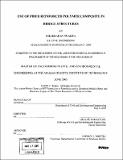Use of fiber reinforced polymer composite in bridge structures
Author(s)
Tuakta, Chakrapan, 1980-
DownloadFull printable version (3.965Mb)
Alternative title
Use of FRP in bridge structures
Other Contributors
Massachusetts Institute of Technology. Dept. of Civil and Environmental Engineering.
Advisor
Oral Buyukozturk.
Terms of use
Metadata
Show full item recordAbstract
Fiber reinforced polymer composite (FRP) is a new construction material, gradually gaining acceptance from civil engineers. Bridge engineering is among the fields in civil engineering benefiting from the introduction of FRP composite. Its advantages over traditional construction materials are its high tensile strength to weight ratio, ability to be molded into various shapes, and potential resistance to environmental conditions, resulting in potentially low maintenance cost. These properties make FRP composite a good alternative for innovative construction. In the past 10 years, experiments have been conducted to investigate the applicability of FRP composite in bridge structures, including the applications of FRP composite girder and bridge deck, column and beam strengthening, etc. This document will first present the basic information of FRP composite, including its mechanical behaviors and manufacturing processes relevant to civil engineering applications. Then the application of FRP composite in bridge engineering will be investigated, through three case studies. Four main issues contributing to the slow acceptance of the material into construction industry as a whole, despite its success in aerospace and automobile industries, are discussed at the end.
Description
Thesis (M. Eng.)--Massachusetts Institute of Technology, Dept. of Civil and Environmental Engineering, 2005. Includes bibliographical references (leaves 45-46).
Date issued
2005Department
Massachusetts Institute of Technology. Department of Civil and Environmental EngineeringPublisher
Massachusetts Institute of Technology
Keywords
Civil and Environmental Engineering.